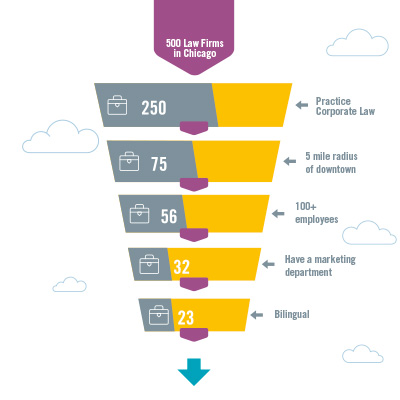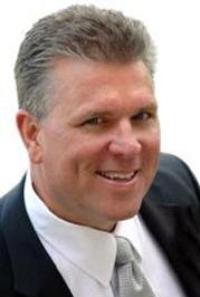Use A Marketing Funnel To Tightly Target Clients
Focusing on the right clients and prospects helps make the most of every minute.
I often hear someone say, “I’m a promotional consultant.” However, the way that person presents his website and social media, and handles client presentations, is contrary to that claim. Ask yourself: are you truly a promotional consultant or are you a product salesperson? Either one is alright—it just depends on what you want.
I also hear people say they need and want to improve their professional skills, or want to be different or perceived differently by their clients—well, here’s your chance. If you are OK with where you are professionally, then you needn’t read further. However, if you are challenged by your current marketing and sales strategies, and want to segment your clients to get the most value for your business, then read on.
Professional Consultant Defined
According to The Merriam-Webster Dictionary, a professional is: (a) a person who receives pay, (b) a person possessing great skill or expertise in a field or activity. A consultant is (a) one who gives expert or professional advice, (b) one who consults another. Simply put, you get paid for your expert advice and for the things and solutions you sell—not just that.
The Mentality Of Many
So many distributors go to market with what I call the “mirror and checkbook” mentality. If a client can fog a mirror and write a check, the distributor counts them as a client. In the short term, this may be alright, but for the long-term sustainability of a loyal client base, this plan is inadequate. Being selective will likely result in more loyal clients, more sales and higher profits.
Begin By Changing Your Mindset
The first step in considering any change begins with you. Take an introspective look at your business. Are things dragging along? Are you not getting the traction from your clients that you have in the past? Have you lost your drive and excitement for the business? I know those feelings; I’ve been there. Begin by looking inward and making a conscious decision to proactively recharge your business. That’s your first step.
Critical Factors
Your next step is to evaluate your business; start by analyzing your current client base. Segment your clients by vertical and horizontal markets, and classify them to determine their current and potential lifetime value.
I give credit for this step of segmenting markets to information I pulled from an article in B2B magazine years ago. The article, “The Top Ten Things Clients Are Looking For,” really drove my business then and continues to be a major dominating force in the way I think about my business and teach others to do so as well.
Each of us has one very distinct thing in common—24 hours in a day. No one has more or less, but how we utilize that time, how proficient we are with our time, can make or break us. It makes no sense to spend time and marketing dollars on clients and prospects who have zero interest in us and what we are offering, or those who are just hard to deal with. However, focusing on the right clients and prospects will make every minute we spend worthwhile. So how do you begin this process?
- List your existing clients in an Excel spreadsheet by segmented categories or markets. Examples of these would be automotive, hospitality, aerospace, banking and finance and transportation to name a few. Next, add columns for gross sales, gross profit, and number of orders, average order size and gross profit percentage. When complete, total the columns. You should add in the numbers for at least the past three years and compare the data. From this exercise you can determine in which vertical markets you have the greatest sales and profitability.
- Next, look carefully at each client and determine their hierarchy. I like using an A through F system; let me explain.
- “A” listed companies are my top-level clients. I consider them so because they appreciate my value, don’t beat me up on price, are open to suggestions and ideas, pay on time, are easy to work with, have potential to grow, spend $30,000 annually, their business gives me a high gross profit, etc.
- “B” through “D” listed clients and prospects are just a step down at each level—each category and its characteristics are different for each distributor. You set the rules.
- “E” listed clients are ones that have all negative characteristics: pay late, always complain, don’t appreciate or value my suggestions, not profitable, etc. Consider getting rid of these clients because they are wasting your time.
- My “F” listed accounts are held in this category for 120 days for evaluation purposes so I can I can determine their true value to my organization.
Evaluation And Marketing To Classification Levels
By having a baseline understanding of my best and worst clients, I can now look at mapping these characteristics when creating my marketing plan and determining to which clients I market to first. Remember, you have only 24 hours in a day, and only “x” number of hours for business activities, so it’s imperative to spend them wisely with those clients that give you the greatest return with the least amount of drama. You want to nurture your accounts—trying where possible to move them up the scale: “C’s” to “B’s” and “B’s” to “A’s.” Keep in mind this doesn’t always happen, but it should be your goal.
Targeting The Right Prospects With The Right Message
This process will also help assure that your marketing message resonates with your targeted audience. Marketing is testing and is not an exact science; however, marketers can make a strong impact with their messaging if it’s targeted properly.
In today’s world it’s not uncommon for distributors to show a self-promotion product, a pen, for example, to their client and cross their fingers that they’ll get the order. But if the client is trying to drive their audience to an event, a pen may not be the right product to accomplish that result. So in that case, the messaging is irrelevant and, therefore, so is the distributor.
When I target prospects I use a funnel sectioned off in layers (see diagram). For example, the number of law firms in Chicago is huge. But when I insert a layer of criteria, I manage to narrow down the field. The more layers or criteria, the narrower the field. This is important because, generally, we try to go after too much new business at once. The average distributor couldn’t handle 50 to 100 new clients; it would be impossible to serve them properly. But if you divide these into small groups and market the right message to each group, your success rate can increase dramatically.

By adding criteria you narrow down the targeted field; remove a criterion or two and you expand the targeted list.
Understanding The Client’s Needs
When we understand the specific needs of our clients, our efforts will pay big dividends. It is imperative that our messaging be about them and not about us. Your message must resonate with your client in a compelling manner in order to get noticed. You can do this by asking questions, reading, doing research and becoming involved in various aspects of their business. For example, when I had my marketing company, one of my strongest vertical markets was hospitality. I went to my clients’ trade shows, spoke at their events, was a member of their associations, read and contributed to their literature and always asked questions about their business. I could talk about it because I was involved in it. By having this knowledge base and being connected, I was seen as being relevant in that space and the go-to guy who understood the needs, concerns and wants of that market. You can do this too.
Translating The Model To Help Your Clients
When you are seen as a professional promotional consultant, your clients will value you as an asset to their success, rather than seeing you as just another products salesperson. Make no mistake—the solution they need might be a product, but as a savvy marketer you can offer so much more.
Cliff Quicksell, Jr., MAS+, serves both as a consultant and acting director of marketing for distributor iPROMOTEu. He has been in the promotional industry for more than 30 years in various capacities. Additionally, Quicksell is president of his own international speaking and consulting company, speaking, coaching and consulting on ways and methods that companies can grow, expand and prosper. He has helped and spoken to audiences in more than eight countries and has published two books and more than 800 articles on sales, marketing and creativity. He can be reached at 301-717-0615, via email at cliff@quicksellspeaks.com or on his LinkedIn profile.

Hear Cliff Quicksell Live
Cliff Quicksell will present a three-hour workshop on using the marketing sales funnel at noon on Sunday, January 8, 2017 during The PPAI Expo in Las Vegas. In this workshop, he will explain the entire process, share examples and answer questions. Register for the session when you register for the show at www.ppai.org/expo.

